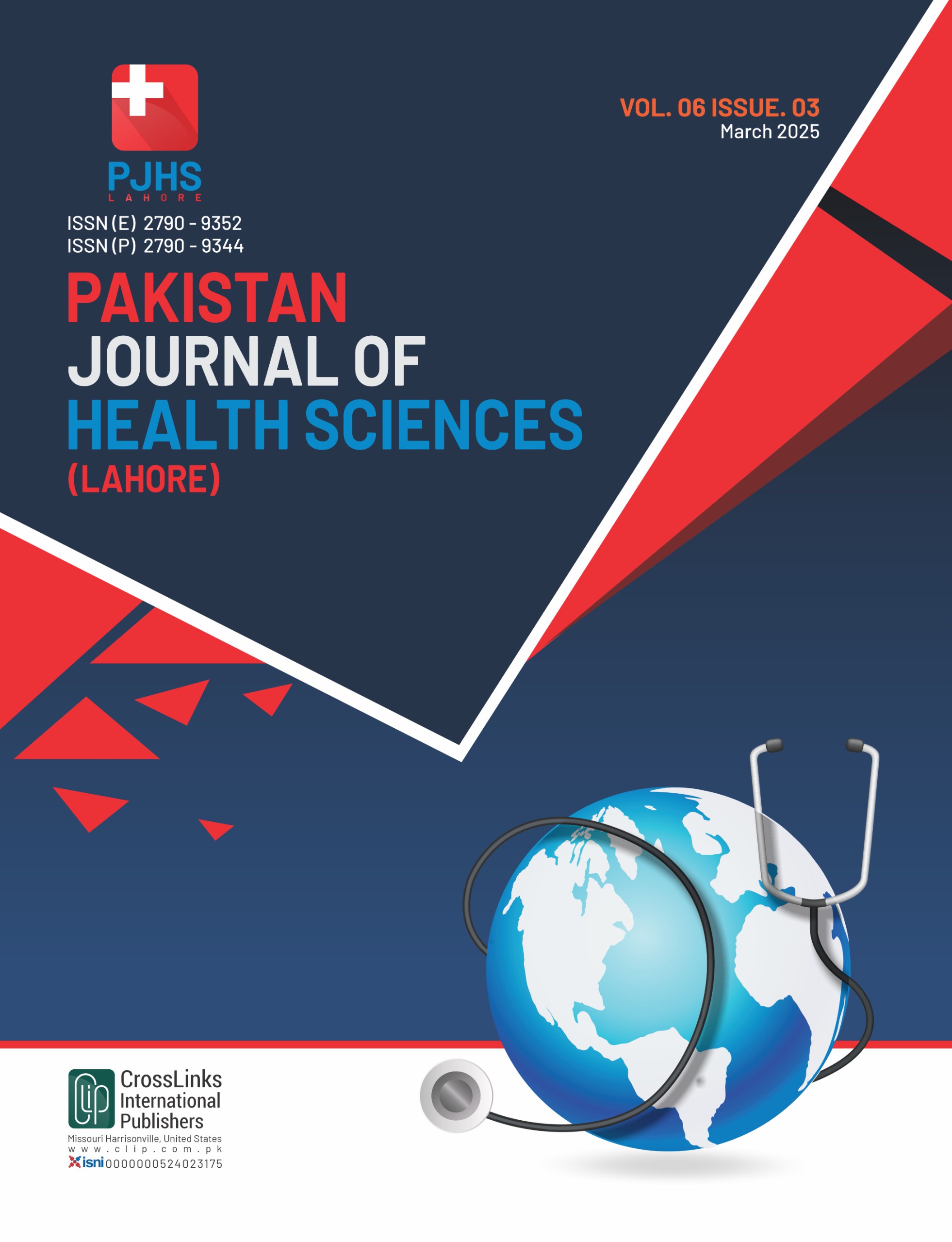Association between Temporomandibular Joint dysfunction and Stress in Undergraduate BDS Students of Rawalpindi/Islamabad
Temporomandibular Joint Dysfunction and Stress
DOI:
https://doi.org/10.54393/pjhs.v6i3.2537Keywords:
Temporomandibular Joint Dysfunction, Stress, Dental Students, Temporomandibular Disorders, Academic StressAbstract
Temporomandibular Joint Dysfunction (TMJD) is a condition linked with psychological factors like stress. Dental students experience high academic stress which makes them an ideal candidate to investigate the relationship between TMJD and stress. Objective: To investigate the association between TMJD and stress in undergraduate BDS students in Rawalpindi and Islamabad. Methods: A cross-sectional study was conducted among 346 BDS students using convenience sampling. Participants completed structured questionnaires, including Fonseca's Anamnestic Index for TMJD and the Perceived Stress Scale. Data analysis was performed using SPSS version 21.0, employing chi-square tests for categorical data and correlation analysis for continuous variables. he study was conducted in two dental institutes namely Margalla Institute of Health Sciences and Foundation University College of Dentistry and Hospital. Results: Out of 346 participants, 264 (76.30%) were females and 82 (23.70%) were males, with a mean age of approximately 20.7 years. The result of the chi-square test for the association between gender and TMJD was a statistically significant relationship (p = 0.00033), with females showing higher rates of mild and moderate TMJD compared to males, whereas the chi-square test for the association between the year of study and TMJD also indicated a significant relationship (p = 0.023). Conclusions: This study found a significant association between stress and Temporomandibular Joint Dysfunction (TMJD) among undergraduate BDS students.
References
Cao Y, Yap AU, Lei J, Zhang MJ, Fu KY. Oral health-related quality of life of patients with acute and chronic temporomandibular disorder diagnostic subtypes. The Journal of the American Dental Association. 2022 Jan; 153(1): 50-8. doi: 10.1016/j.adaj.2021.07.011. DOI: https://doi.org/10.1016/j.adaj.2021.07.011
Marupova MH, Kubaev AS, Khazratov AI. Diagnosis and Treatment of Pain Syndrome Temporomandibular Joint Dysfunction Syndrome. Вестник магистратуры. 2022; 5-1(128): 10-1.
Mozumder MK. Reliability and validity of the Perceived Stress Scale in Bangladesh. PLOS One. 2022 Oct; 17(10): e0276837. doi: 10.1371/journal.pone.0276837. DOI: https://doi.org/10.1371/journal.pone.0276837
Pantoja LL, de Toledo IP, Pupo YM, Porporatti AL, De Luca Canto G, Zwir LF et al. Prevalence of degenerative joint disease of the temporomandibular joint: a systematic review. Clinical oral investigations. 2019 May; 23: 2475-88. doi: 10.1007/s00784-018-2664-y. DOI: https://doi.org/10.1007/s00784-018-2664-y
Slade GD, Ohrbach R, Greenspan JD, Fillingim RB, Bair E, Sanders AE et al. Painful temporomandibular disorder: decade of discovery from OPPERA studies. Journal of Dental Research. 2016 Sep; 95(10): 1084-92. doi: 10.1177/0022034516653743. DOI: https://doi.org/10.1177/0022034516653743
Valesan LF, Da-Cas CD, Réus JC, Denardin AC, Garanhani RR, Bonotto D et al. Prevalence of temporomandibular joint disorders: a systematic review and meta-analysis. Clinical Oral Investigations. 2021 Feb; 25: 441-53. doi: 10.1007/s00784-020-03710-w. DOI: https://doi.org/10.1007/s00784-020-03710-w
Malik W, Malik S, Shakir S, Khan A, Qadeer A, Malik W. Severity patterns of Temporomandibular disorders in young adults with suspected clinical features. Pakistan Journal of Medical & Health Sciences. 2022 Apr; 16(02): 1143-. doi: 10.53350/pjmhs221621143. DOI: https://doi.org/10.53350/pjmhs221621143
Shabila NR, Jason A, Marpaung C. Uji Validitas Dan Reliabilitas Kuesioner Fonseca Anamnestic Index Versi Bahasa Indonesia Populasi Usia 19-21 Tahun (Penelitian). Jurnal Kedokteran Gigi Terpadu. 2020 Feb; 2(2). doi: 10.25105/jkgt.v2i2.8793. DOI: https://doi.org/10.25105/jkgt.v2i2.8793
Yap AU and Marpaung C. Severity and form of temporomandibular disorder symptoms: Functional, physical, and psychosocial impacts. CRANIO®. 2024 Mar; 42(2): 142-9. doi: 10.1080/08869634.2021.1950336. DOI: https://doi.org/10.1080/08869634.2021.1950336
Özdinç S, Ata H, Selcuk H, Can HB, Sermenli N, Turan FN. Temporomandibular joint disorder determined by Fonseca anamnestic index and associated factors in 18-to 27-year-old university students. CRANIO®. 2020 Sep; 38(5): 327-32. doi: 10.1080/08869634.2018.1513442. DOI: https://doi.org/10.1080/08869634.2018.1513442
Palmer J and Durham J. Temporomandibular disorders. BJA Education. 2021 Feb; 21(2): 44-50. doi: 10.1016/j.bjae.2020.11.001. DOI: https://doi.org/10.1016/j.bjae.2020.11.001
Derwich M, Mitus-Kenig M, Pawlowska E. Interdisciplinary approach to the temporomandibular joint osteoarthritis-review of the literature. Medicina. 2020 May; 56(5): 225. doi: 10.3390/medicina56050225. DOI: https://doi.org/10.3390/medicina56050225
Salamon NM and Casselman JW. Temporomandibular joint disorders: a pictorial review. InSeminars in Musculoskeletal Radiology 2020 Oct; 24(05): 591-607. Thieme Medical Publishers. doi: 10.1055/s-0040-1701631. DOI: https://doi.org/10.1055/s-0040-1701631
ur Rehman I, Hassan H, Salman Amin MH, Tayyab TF, Rehman F. Prevalence of temporomandibular joint disorders and their association with anxiety and bruxism in dental students and house officers: a cross-sectional study from Punjab, Pakistan. Rawal Medical Journal. 2024 Aug; 49(3): 606.
Zhang MJ, Yap AU, Lei J, Fu KY. Psychometric evaluation of the Chinese version of the Fonseca anamnestic index for temporomandibular disorders. Journal of Oral Rehabilitation. 2020 Mar; 47(3): 313-8. doi: 10.1111/joor.12893. DOI: https://doi.org/10.1111/joor.12893
Siqueira Reis R, Ferreira Hino AA, Romélio Rodriguez Añez C. Perceived stress scale: Reliability and validity study in Brazil. Journal of Health Psychology. 2010 Jan; 15(1): 107-14. doi: 10.1177/1359105309346343. DOI: https://doi.org/10.1177/1359105309346343
Ahmed H, Yasmeen S, Ishaque F, Naz A, Khan F, Iqbal S. Prevalence and Associated factors of Temporomandibular Joint dysfunction among young adults in Karachi. Journal of Rawalpindi Medical College. 2021 Jun; 25(2). doi: 10.37939/jrmc.v25i2.1570. DOI: https://doi.org/10.37939/jrmc.v25i2.1570
Kumar S, Dagli RJ, Mathur A, Jain M, Prabu D, Kulkarni S. Perceived sources of stress amongst Indian dental students. European Journal of Dental Education. 2009 Feb; 13(1): 39-45. doi: 10.1111/j.1600-0579.2008.00535.x. DOI: https://doi.org/10.1111/j.1600-0579.2008.00535.x
Minervini G, Franco R, Marrapodi MM, Fiorillo L, Cervino G, Cicciù M. Prevalence of temporomandibular disorders in children and adolescents evaluated with Diagnostic Criteria for Temporomandibular Disorders: a systematic review with meta‐analysis. Journal of Oral Rehabilitation. 2023 Jun; 50(6): 522-30. doi: 10.1111/joor.13446. DOI: https://doi.org/10.1111/joor.13446
Murtaza F, Habib MU, Raza MA, Jafri MR, Shah SM. Prevalence of musculoskeletal disorders among dentistry students in clinical work environment of Lahore, Pakistan. Rawal Medical Journal. 2021 Jun; 46(2): 361.
Gaş S, Ekşi Özsoy H, Cesur Aydın K. The association between sleep quality, depression, anxiety and stress levels, and temporomandibular joint disorders among Turkish dental students during the COVID-19 pandemic. CRANIO®. 2023 Nov; 41(6): 550-5. doi: 10.1080/08869634.2021.1883364. DOI: https://doi.org/10.1080/08869634.2021.1883364
Glaros AG, Marszalek JM, Williams KB. Longitudinal multilevel modeling of facial pain, muscle tension, and stress. Journal of Dental Research. 2016 Apr; 95(4): 416-22. doi: 10.1177/0022034515625216. DOI: https://doi.org/10.1177/0022034515625216
Flueraşu MI, Bocşan IC, Țig IA, Iacob SM, Popa D, Buduru S. The epidemiology of bruxism in relation to psychological factors. International Journal of Environmental Research and Public Health. 2022 Jan; 19(2): 691. doi: 10.3390/ijerph19020691. DOI: https://doi.org/10.3390/ijerph19020691
Mortazavi N, Tabatabaei AH, Mohammadi M, Rajabi A. Is bruxism associated with temporomandibular joint disorders? A systematic review and meta-analysis. Evidence-Based Dentistry. 2023 Sep; 24(3): 144-. doi: 10.1038/s41432-023-00911-6. DOI: https://doi.org/10.1038/s41432-023-00911-6
Downloads
Published
How to Cite
Issue
Section
License
Copyright (c) 2025 Pakistan Journal of Health Sciences

This work is licensed under a Creative Commons Attribution 4.0 International License.
This is an open-access journal and all the published articles / items are distributed under the terms of the Creative Commons Attribution License, which permits unrestricted use, distribution, and reproduction in any medium, provided the original author and source are credited. For comments













